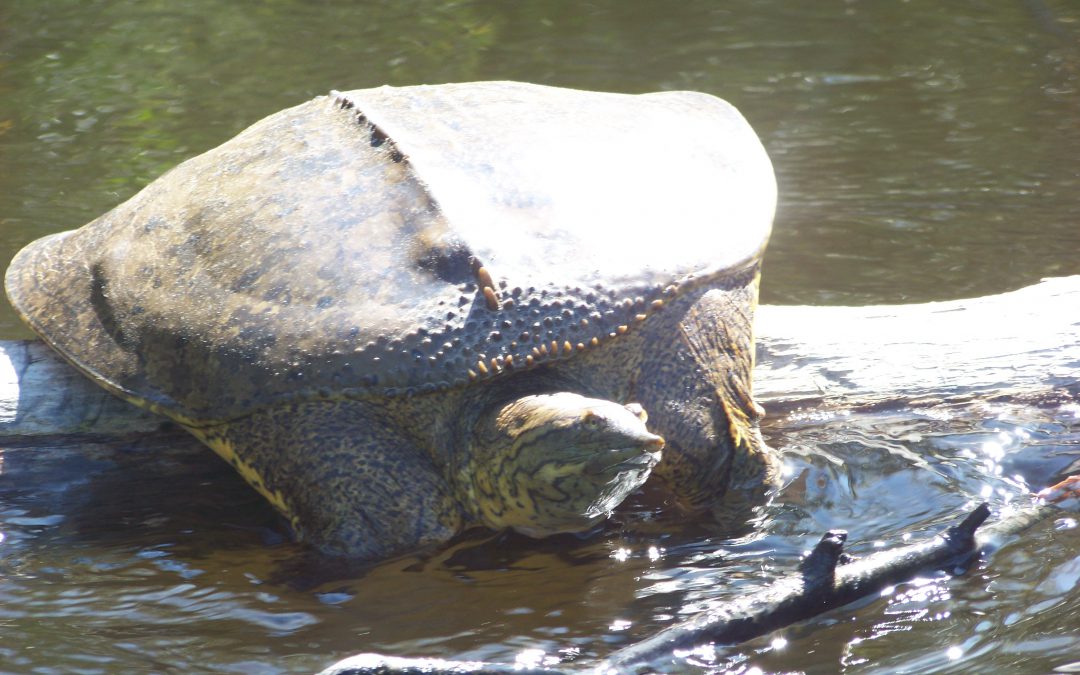
by Rick O'Connor | Feb 20, 2020
These are some of the most unique turtles in the Order Chelonia. Softshells are very distinct with their flat, leathery shells and long tubular snouts. These guys like to lie beneath the sand of Florida’s rivers, buried except their eyes and snout, awaiting passing fish to ambush. They have very long necks to extend their reach during a strike and three sharp bony plates in the roof of their mouths to rip fish flesh. Those handling these should be careful. They have a LONG reach and a nasty bite.
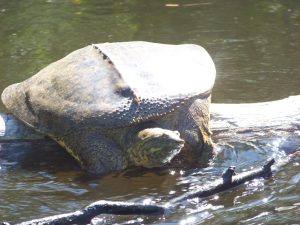
A large Florida softshell turtle basking on a log in Blackwater River.
Photo: Molly O’Connor
There are believed to be 22 species of softshells around the globe but only three live in Florida, and two of those are only found in the western panhandle, one is only found in Escambia County.
The Florida softshell (Apalone ferox) is found throughout the state. Unlike the other Florida species, this one can be found in slow moving streams, ponds, lakes, retention ponds, and even some brackish systems. It prefers to NOT inhabit faster moving rivers. It is the largest of the Florida softshells reaching a carapace length of 30 inches (2.5’) and a mass of 100 pounds! Like many turtles, females are large than males. Besides size, the Florida softshell can be distinguished from the others by the low, round tubercles along the nape of the carapace. This turtle is often seen basking in quiet waterways and will defend itself aggressively. Like many freshwater turtles, Florida softshells nest during daylight hours in sandy soils. They typically lay 15-25 eggs and more than one clutch a year. Unlike other freshwater turtles, sex is not determined by egg temperature but rather by genetics. Though they are fish eaters, much of their diet consist of snails and insects. Crayfish, clams, snakes, turtles, and birds (though rare) have been found in their gut. This species has few predators as adults but are heavily preyed upon by humans for the food markets outside of Florida.
The Gulf Coast Spiny Softshell (Apalone spinifera aspera) is smaller than the Florida softshell, but larger than the Gulf Coast Smooth, with maximum carapace length at 18 inches. They can be distinguished from the other softshells by having spiny, or spike looking tubercles along the nape of the carapace. The hatchlings are tan with numerous small spots and dark thin lines along the margin of the carapace. In Florida, this softshell is only found in the panhandle and in the St. Marys River in Nassau County. It prefers fast moving rivers but will move into quieter waters if the Florida softshell is not present. Like many turtles, they nest during daylight hours in sandy soils during the spring. Clutch size is 20-25 eggs and they lay more than one clutch per year. Incubation is between 60-70 days. They are bottom feeders feeding mostly on crayfish and fish. There are few adult predators and no commercial fishery for this species.
The Gulf Coast Smooth Softshell (Apalone mutica calvata) has only been found in Escambia County within our state. As the name implies, the nape of the carapace does not have the round or spike-like tubercles – rather, it is smooth. It is a smaller softshell, with a carapace length of 12 inches. The young have large circular spots which are harder to see in adults. It has a milder disposition than most softshells, preferring to withdraw into the shell rather than bite. It prefers rivers over other types of water bodies and has only been found in the Escambia River within our state, and only in the upper – faster moving portions of it. They have been found in quiet waters connected to this river. It seems to like sections of the river where sandbars are common, buried in sand near them awaiting fish. They will quickly retreat to the deep part of the river when encountered. The GCSS will use these sandbars for nesting in the spring, laying only about 6-8 eggs, and typically more than one clutch each season. The eggs incubate for 60-70 days and sex is determined by genetics, not temperature. Though fish eaters, insects are much of their diet. There is no commercial fishery for this small turtle.
Like all turtles, nest predation is high for softshells, but river flooding also takes a lot of nests.
All freshwater turtles afford some protection (more some than others). Residents can collect no more than one softshell/day for noncommercial use, no more than two in your possession, and no eggs.
These are really neat looking turtles and it is very exciting to see them while paddling our rivers. We hope you get to see one soon.
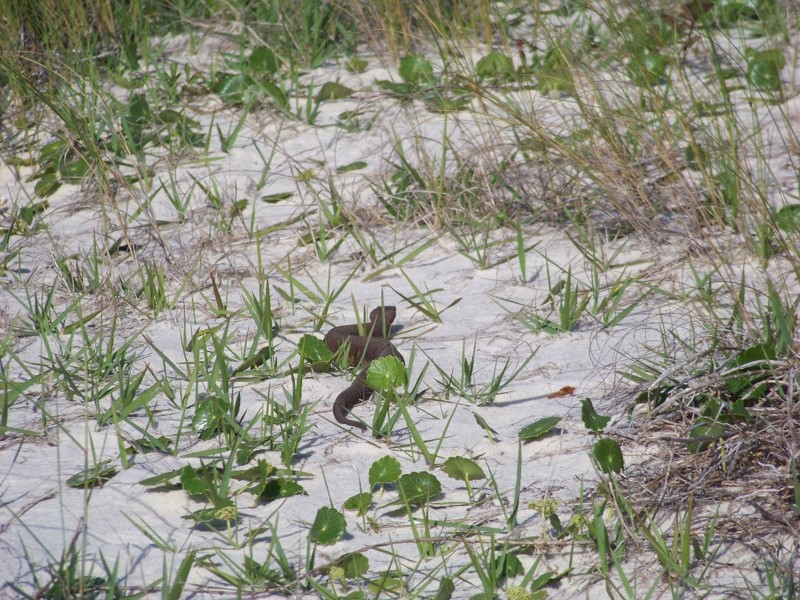
by Rick O'Connor | Feb 13, 2020
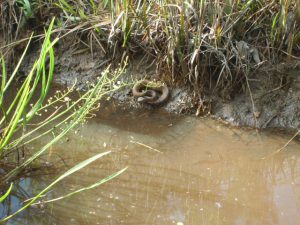
An eastern cottonmouth basking near a creek in a swampy area of Florida.
Photo: Tommy Carter
When you think of reptiles you typically think of tropical rainforest or the desert. However, there is at least one member of the three orders of reptiles that do live in the sea. Saltwater crocodiles are found in the Indo-Pacific region as are about 50 species of sea snakes. There is one marine lizard, the marine iguana of the Galapagos Islands, and then the marine (or sea) turtles. These are found worldwide and are the only true marine reptiles found in the Gulf of Mexico.
Sea turtles are very charismatic animals and beloved by many. Five of the seven species are found in the Gulf. These include the Loggerhead, which is the most common, the Green, the Hawksbill, the Leatherback, and the rarest of all – the Kemp’s Ridley.
Many in our area are very familiar with the nesting behavior of these long-ranged animals. They do have strong site fidelity and navigate across the Gulf, or from more afar, to their nesting beaches – many here in the Pensacola Beach area. The males and females court and mate just offshore in early spring. The females then approach the beach after dark to lay about 100 eggs in a deep hole. She then returns the to the Gulf never to see her offspring. Many females will lay more than one clutch in a season.
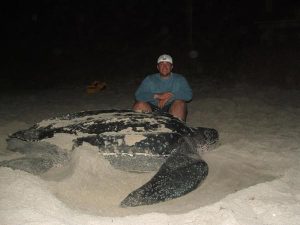
The largest of the sea turtles, the leatherback.
Photo: Dr. Andrew Colman
The eggs incubate for 60-70 days and their temperature determines whether they will be male or female, warmer eggs become females. The hatchlings hatch beneath the sand and begin to dig out. If they detect problems, such as warm sand (we believe meaning daylight hours) or vibrations (we believe meaning predators) they will remain suspended until those potential threats are no more. The “run” (all hatchlings at once) usually occurs under the cover of darkness to avoid predators. The hatchlings scramble towards the Gulf finding their way by light reflecting off the water. Ghost crabs, fox, raccoon, and other predators take almost 90% of them, and the 10% who do reach the Gulf still have predatory birds and fish to deal with. Those who make it past this gauntlet head for the Sargassum weed offshore to begin their lives.
These are large animals, some reaching 1000 pounds, but most are in the 300-400 pound range, and long lived, some reaching 100 years. It takes many years to become sexually mature and typically long-lived / low reproductive animals are targets for population issues when disasters or threats arise. Many creatures eat the small hatchings, but there are few predators on the large reproducing adults. However, in recent years humans have played a role in the decline of the adult population and all five species are now listed as either threatened or endangered and are protected in the U.S. There are a couple of local ordinances developed to adhere to federal law requiring protection. One is the turtle friendly lighting ordinance, which is enforced during nesting season (May 1 – Oct 31), and the Leave No Trace ordinance requiring all chairs, tents, etc. to be removed from the beach during the evening hours. There are other things that locals can do to help protect these animals such as: fill in holes dug on the beach during the day, discard trash and plastic in proper receptacles, avoid snagging with fishing line and (if so) properly remove, and watch when boating offshore to avoid collisions.
If we include the barrier islands there are more coastal reptiles beyond the sea turtles. There are freshwater ponds which can harbor a variety of freshwater turtles. I have personally seen cooters, sliders, and even a snapping turtle on Pensacola Beach. Many coastal islands harbor the terrestrial gopher tortoise and wooded areas could harbor the box turtles. In the salt marsh you may find the only brackish water turtle in the U.S., the diamondback terrapin. These turtles do nest on our beaches and are unique to see. Freshwater turtle reproductive cycles are very similar to sea turtles, albeit most nest during daylight hours.
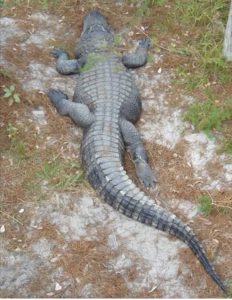
An American Alligator basking on shore.
Photo: Molly O’Connor
The American alligator can also be found in freshwater ponds, and even swimming in saltwater. They can reach lengths of 12 feet, though there are records of 15 footers. These animals actually do not like encounters with humans and will do their best to avoid us. Problems begin when they are fed and loose that fear. I have witnessed locals in Louisiana feeding alligators, but it is a felony in Florida. Males will “bello” in the spring to attract females and ward off competing males. Females will lay eggs in a nest made of vegetation near the shoreline and guard these, and the hatchlings, during and after birth. They can be dangerous at this time and people should avoid getting near.
We have several native species of lizards that call the islands home. The six-lined race runners and the green anole to name two. However, non-native and invasive lizards are on the increase. It is believed there are actually more non-native and invasive lizards in Florida than native ones. The Argentina Tegu and the Cuban Anole are both problems and the Brown Anole is now established in Gulf Breeze, East Hill, and Perdido Key – probably other locations as well. Growing up I routinely find the horned lizard in our area. I was not aware then they were non-native, but by the 1970s you could only find them on our barrier islands, and today sightings are rare.
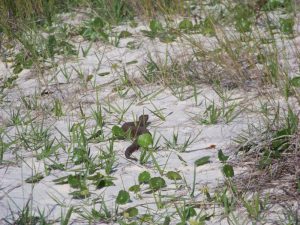
An eastern cottonmouth crossing a beach.
Photo: Molly O’Connor
Then there are the snakes.
Like all reptiles, snakes like dry xeric environments like barrier islands. We have 46 species in the state of Florida, and many can be found near the coast. Though we have no sea snakes in the Gulf, all of our coastal snakes are excellent swimmers and have been seen swimming to the barrier islands. Of most concern to residents are the venomous ones. There are six venomous snakes in our area and four of them can be found on barrier islands. These include the Eastern Diamondback Rattlesnake, the Pygmy Rattlesnake, the Eastern Coral Snake, and the Eastern Cottonmouth. There has been a recent surge in cottonmouth encounters on islands and this could be due to more people with more development causing more encounters, or there may be an increase in their populations. Cottonmouths are more common in wet areas and usually want to be near freshwater. Current surveys are trying to determine how frequently encounters do occur.
Not everyone agrees, but I think reptiles are fascinating animals and a unique part of the Gulf biosphere. We hope others will appreciate them more and learn to live with and enjoy them.
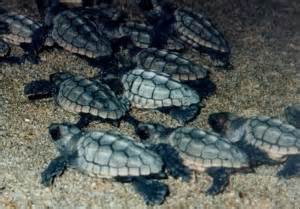
by Rick O'Connor | Feb 5, 2020
This is one of the most beloved animals on the planet… sea turtles. Discussions and debates over all sorts of local issues occur but when sea turtles enter the discussion, most agree – “we like sea turtles”, “we have nothing against sea turtles”. There are nonprofit groups, professional hospitals, and special rescue centers, devoted to helping them. I think everyone would agree, seeing one swimming near the shore, or nesting, is one of the most exciting things they will ever see. For folks visiting our beaches, seeing the white sand and emerald green waters is amazing, but it takes their visit to a whole other level if they encounter a sea turtle.

The largest of the sea turtles, the leatherback.
Photo: Dr. Andrew Colman
They are one of the older members of the living reptiles dating back 150 million years. Not only are they one of the largest members of the reptile group, they are some of the largest marine animals we encounter in the Gulf of Mexico.
There are five species of marine turtles in the Gulf represented by two families. The largest of them all is the giant leatherbacks (Dermochelys coriacea). This beast can reach 1000 pounds and have a carapace length of six feet. Their shell resembles a leatherjacket and does not have scales. Because of their large size, they can tolerate colder temperatures than other marine turtles and found all over the globe. They feed almost exclusively on jellyfish and often entangled in open ocean longlines. There is a problem distinguishing clear plastic bags from jellyfish and many are found dead on beaches after ingesting them. Like all sea turtles, they approach land during the summer evenings to lay their eggs above the high tide line. The eggs incubate within the nest for 65-75 days and sex determination is based on the temperature of the incubating eggs; warmer eggs producing females. Also, like other marine turtles, the hatchlings can be disoriented by artificial lighting or become trapped in human debris, or unnatural holes, on the beach. These animals are known to nest in Florida and they are currently listed as federally endangered and are completely protected.
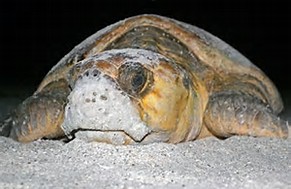
The large head of a loggerhead sea turtle.
Photo: UF IFAS
The other four species are found in the Family Chelonidae and have the characteristic scaled carapace. Much smaller than the leatherback, these are still big animals. The most common are the loggerhead sea turtles (Caretta caretta). As the name suggest, the head of this sea turtle is quite large. Their carapace can reach lengths of four feet and they can weigh up to 450 pounds. The head usually has four scutes between the eyes and three scutes along the bridge connecting the carapace to the plastron. This animal prefers to feed on a variety of invertebrates from clams, to crabs, to even horseshoe crabs. It too is an evening nester and the young have similar problems as the leatherback hatchlings. The tracks of the nesting turtle can be identified by the alternating pattern made by the flippers. One flipper first, then the next. The loggerhead is currently listed as a federally threatened species.
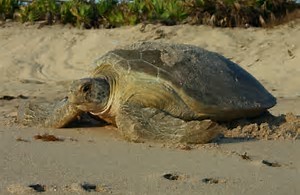
A green sea turtle on a Florida beach.
Photo: Florida Sea Grant
The green sea turtle (Chelonia mydas) is called so not for the color of its shell, but for the color of its internal body fat. They are fans of eating seagrasses, particularly “turtle grass” and other plants, which produce the green coloration of the fat. The fat is used to produce a world favorite, “turtle soup”, and has been a problem for the conservation of this species in some parts of the world. At one time, most green turtles nested in south Florida, but each year the number nesting in the north has increased. They can be distinguished from the loggerhead in that (1) their head is not as big, (2) there are only two scales between the eyes, and (3) their flipper pattern in sand is not alternating; green turtles throw both flippers forward at the same time. Green turtles are listed as federally threatened.
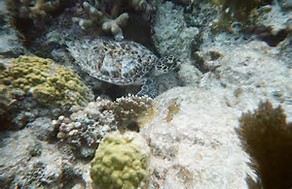
A hawksbill sea turtle resting on a coral reef in the Florida Keys.
Photo: Molly O’Connor
The hawksbill turtle (Eretmochelys imbricata) is more tropical in distribution. They are a bit smaller, with a carapace length of three feet and a weight of 187 pounds, but their diet of sponges is another reason you do not find them often in the northern Gulf of Mexico. To feed on these, they have a “hawks-bill” designed to rip the sponges from their anchorages. Their shell is gorgeous and prized in the jewelry trade. “Tortoise-shell” glasses and earrings are very popular.
The most endangered of them all is the small Kemp’s Ridley sea turtle (Lepidochelys kempii). This little guy has a carapace length of a little over two feet and weighs in at no more than 100 pounds. These guys are commonly seen in the Big Bend area of Florida but for years no one knew where they nested. That was until 1947 when an engineer from Mexico found them nesting in large numbers (up to 40,000) at one time, in broad daylight in Rancho Nuevo, Mexico. This was problematic for the turtle because the locals would wait for the nesting to be complete before they would take the females and the eggs. Protected today they now face the problem that their migratory path across the Gulf takes them through Texas and Louisiana shrimping grounds, and through the 2010 Deep Water Horizon oil spill field. Not to mention that illegal poaching still occurs. Though all species of sea turtles have had problem with shrimp trawls, the Kemps had a particular problem, which led to the develop of the now required Turtle Excluder Device (T.E.D.S) found on shrimp trawls in the U.S. today. Sea turtles have strong site fidelity for nesting and in the 1980s many Kemp’s Ridley eggs were re-located to beaches in Texas in hopes to move the nesting to other locations. The program had some success and they have been reported to nest in Florida. Their diet consists primarily of crabs but there have been reports of them removing bait from fishing lines fishing from piers over the Gulf. This is species is federally endangered and is considered by many to be the most endangered sea turtle species on the planet.
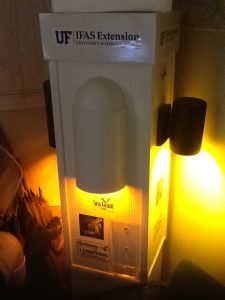
Turtle friendly lighting.
Photo: Rick O’Connor
Sea turtles face numerous human-caused problems including (1) artificial lighting that disorient hatchlings and cause mortality to 50% (or more) of the hatchlings, (2) items left on beaches (such as chairs, tents, etc.) that can impede adults and entrap hatchlings, (3) large holes dug on beaches in which hatchlings fall and cannot get out, (4) marine debris (such as plastics) which they confuse with prey and swallow, (5) boat strikes, sea turtles must surface to breath and can become easy targets, and (6) discarded fishing gear, in which they can become entangled and drown. These are simple things we can correct and protect these amazing Florida turtles.
References
Buhlmann, K., T. Tuberville, W. Gibbons. 2008. Turtles of the Southeast. University of Georgia Press, Athens GA. Pp. 252.
Florida’s Endangered and Threatened Species. 2018. Florida Fish and Wildlife Conservation Commission. https://myfwc.com/media/1945/threatend-endangered-species.pdf,
Species of Sea Turtle Found in Florida. Florida Fish and Wildlife Conservation Commission. https://myfwc.com/research/wildlife/sea-turtles/florida/species/.
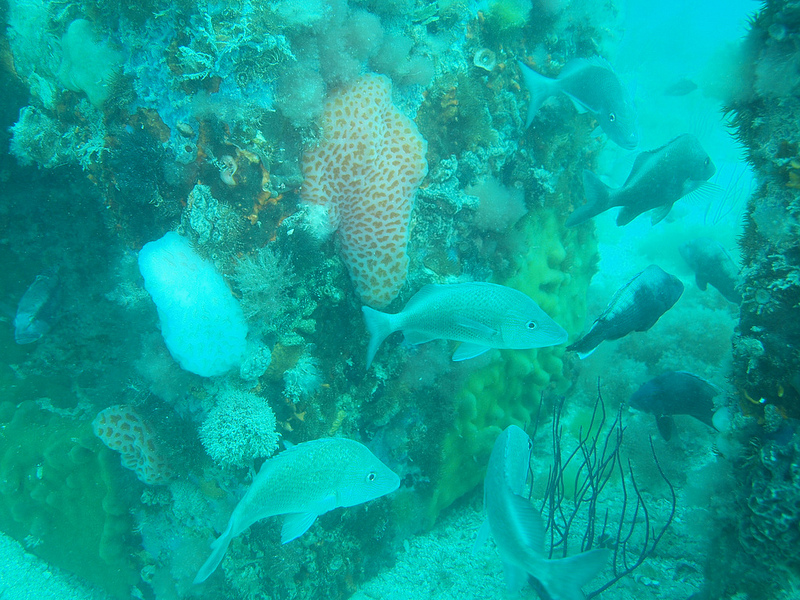
by Rick O'Connor | Jan 29, 2020
If you ask a kid who is standing on the beach looking at the open Gulf of Mexico “what kinds of creatures do you think live out there?” More often than not – they would say “FISH”.
And they would not be wrong.
According the Dr. Dickson Hoese and Dr. Richard Moore, in their book Fishes of the Gulf of Mexico, there are 497 species of fishes in the Gulf. However, they focused their book on the fish of the northwestern Gulf over the continental shelf. So, this would not include many of the tropical species of the coral reef regions to the south and none of the mysterious deep-sea species in the deepest part of the Gulf. Add to this, the book was published in 1977, so there have probably been more species discovered.
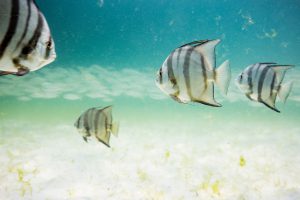
Schools of fish swim by the turtle reef off of Grayton Beach, Florida. Photo credit: University of Florida / Bernard Brzezinski
Fish are one of the more diverse groups of vertebrates on the planet. They can inhabit freshwater, brackish, and seawater habitats. Because all rivers lead to the sea, and all seas are connected, you would think fish species could travel anywhere around the planet. However, there are physical and biological barriers that isolate groups to certain parts of the ocean. In the Gulf, we have two such groups. The Carolina Group are species found in the northern Gulf and the Atlantic coast of the United States. The Western Atlantic Group are found in the southern Gulf, Caribbean, and south to Brazil. The primary factors dictating the distribution of these fish, and those within the groups, are salinity, temperature, and the bottom type.
Off the Texas coast there is less rain, thus a higher salinity; it has been reported as high 70 parts per thousand (mean seawater is 35 ppt). The shelf off Louisiana is bathed with freshwater from two major rivers and salinities can be as low as 10 ppt. The Florida shelf is more limestone than sand and mud. This, along with warm temperatures, allow corals and sponges to grow and the fish assemblages change accordingly.
Some species of fish are stenohaline – meaning they require a specific salinity for survival, such as seahorses and angelfish. Euryhaline fish are those who have a high tolerance for wide swings in salinity, such as mullet and croaker.
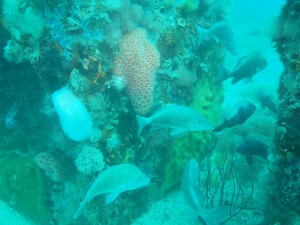
Courtesy of Florida Sea Grant. In total, it takes about 3 – 5 years for reefs to reach a level of maximum production for both fish and invertebrate species.
Forty-three of the 497 species are cartilaginous fish, lacking true bone. Twenty-five are sharks, the other 18 are rays. Sharks differ from rays in that their gill slits are on the side of their heads and the pectoral fins begins behind these slits. Rays on the other hand have their gill slits on the bottom (ventral) side of their body and the pectoral begins before them. Not all rays have stinging barbs. The skates lack them but do have “thorns” on their backs. The giant manta also lacks barbs.
Sharks are one of the more feared animals on the planet. 13 the 25 species belong to the requiem shark family, which includes bull, tiger, and lemon sharks. There are five types of hammerheads, dogfish, and the largest fish of all… the whale shark; reaching over 40 feet. The most feared of sharks is the great white. Though not believed to be a resident, there are reports of this fish in the Gulf. They tend to stay offshore in the cooler waters, but there are inshore reports.
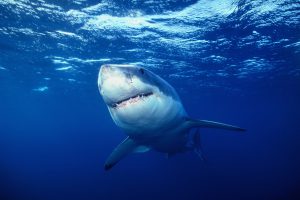
The impressive jaws of the Great White.
Photo: UF IFAS
There is great variety in the 472 species of bony fishes found in the Gulf. Sturgeons are one of the more ancient groups. These fish migrate from freshwater, to the Gulf, and back and are endangered species in parts of its range. Gars are a close cousin and another ancient “dinosaur” fish. Eels are found here and resemble snakes. As a matter of fact, some have reported sea snakes in the Gulf only to learn later they caught an eel. Eels differ from snakes in having fins and gills. Herring and sardines are one of the more commercially sought-after fish species. Their bodies are processed to make fish meal, pet food, and used in some cosmetics. There are flying fish in the Gulf, though they do not actually fly… they glide – but can do so for over 100 yards. Grouper are one of the more diverse families in the Gulf and are a popular food fish across the region. There untold numbers of tropical reef fish. Surgeons, triggerfish, angelfish, tangs, and other colorful fish are amazing to see. Stargazers are bottom dwelling fish that can produce a mild electric shock if disturbed. Large billfish, such as marlins and sailfins, are very popular sport fish and common in the Gulf. Puffers are fish that can inflate when threatened and there are several different kinds. And one of the strangest of all are the ocean sunfish – the Mola. Molas are large-disk shaped fish with reduced fins. They are not great swimmers are often seen floating on their sides waiting for potential prey, such as jellyfish.

We could go on and on about the amazing fish of the Gulf. There are many who know them by fishing for them. Others are “fish watchers” exploring the great variety by snorkeling or diving. We encourage to take some time and visit a local aquarium where you can see, and learn more about, the Fish of the Gulf.
Reference
Hoese, H.D., R.H. Moore. 1977. Fishes of the Gulf of Mexico; Texas, Louisiana, and Adjacent Waters. Texas A&M University Press. College Station Texas. Pp. 327.
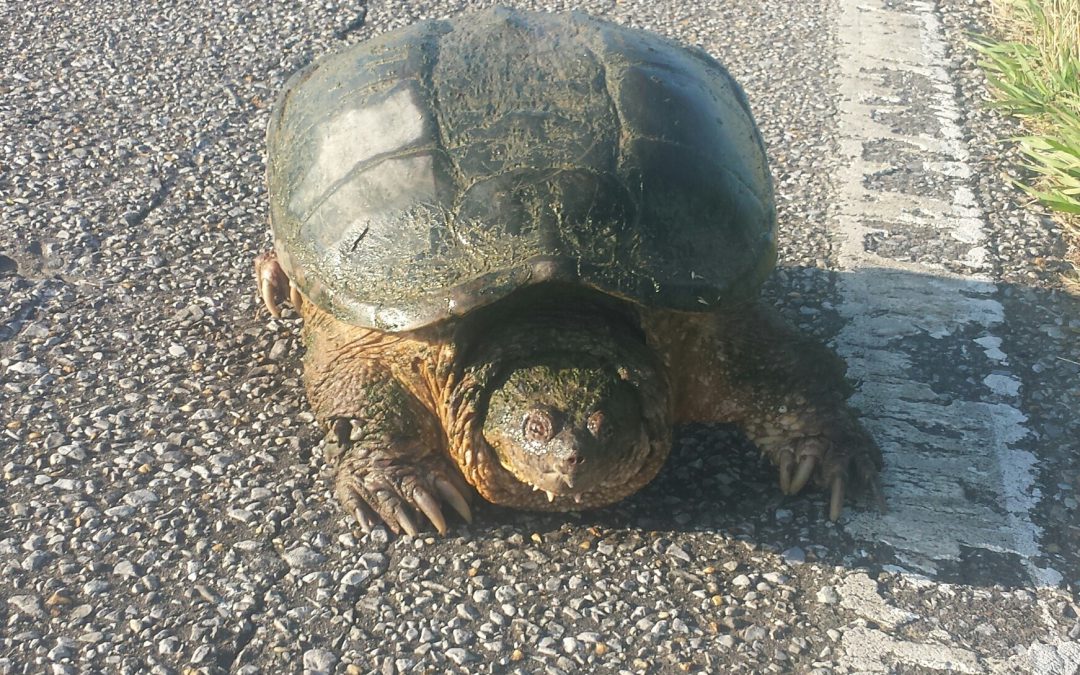
by Rick O'Connor | Jan 21, 2020
There are a couple of things you learn when working with youth in turtle education.
1) ALL turtles are snapping turtles
2) Snapping turtles are dangerous
I grew up in a sand hill area of Pensacola and we found box turtles all of the time. We had one as a “pet” and his name was “Snappy”. Oh, I forgot… all turtles are males.
That said, others are well aware of this unique species of turtle in our state. It does not look like your typical turtle. (1) They are large… can be very large – some male alligator snappers have weighed in at 165 lbs.! (2) Their plastron is greatly reduced, almost not there. Because of this their legs can bend closer to the ground and walk more like dogs than other turtles do. We call this cursorial locomotion. Snappers are not cursorial, but they are close, and because of this can move much faster across land. (3) Their carapace is almost square shaped (versus round or oval) and have large ridges making them look like dinosaurs. (4) They have longer tails than most turtles, some species have scales pointing vertically making them look even more like dinosaurs. Scientists have wondered whether this unique reduced plastron-better locomotion design was the original for turtles (and they lost it), or they are the “new kids on the block”. The evidence right now suggests they are “the new kids”.
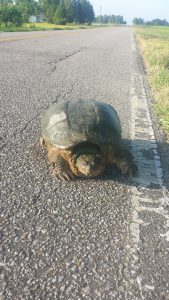
The relatively smooth shell of a common snapping turtle crossing a highway in NW Florida.
Photo: Libbie Johnson
And of course, there is the “SNAP”. These are very strong animals who seem to crouch and lunge as they quickly SNAP at potential predators – as quickly as 78 milliseconds/bite. I remember once stopping on a rural highway to get one out of the road. I grabbed it safely behind the nape and near the rear. That sucker crouched and snapped, and I could hardly hold on. I was amazed by its strength. It did not understand I was trying to help. You do need to be careful around these guys.
In Florida, we have two species of snapping turtles; the common and the alligator. They look very similar and are often confused (everyone seen is called an alligator snapper). There are couple of ways to tell them apart.
1) The alligator snapper has a large head with a hooked beak.
2) The alligator snapper’s carapace is slightly squarer and has three ridges of enlarged scales that make it look “spiked”; where the common snapper lacks these.
3) The tail of the common snapper has vertical “spiked” scales; which the alligator lacks.
4) And the textbook range of the alligator snapper is the Florida panhandle. Basically, if you are south or east of the Suwannee River, it should not be around – you are seeing the common.
As the name implies, the common snapper (Chelydra serpentina) is found throughout the state – except the Florida Keys. There are actually two subspecies; the Common (C. serpentia serpentina) which is found west of the Suwannee River and the Florida Snapper (C. serpentina osceola). This species uses a wide range of habitats. They have been found in small creeks, ponds, floodplain swamps, wet areas of pine flatwoods, and on golf courses.
These are very mobile turtles, often seen crossing highways looking for nesting locations, dispersing to new territory, or their pond has just dried up and they need a new one. Interestingly they have an expanded diet. Most think of snapping turtles as fish eaters, but common snappers are known to consume large amounts of aquatic plants and invertebrates.
Like all turtles, snappers must find high-dry ground for nesting. Nesting begins around April and runs through June. In south Florida, nesting can begin as early as February. They select a variety of habitats and typically lay 2-30 eggs deep in the substrate. These incubate for about 75 days and the temperature of the egg determines its sex; warmer eggs produce females. Nest predation is a problem for all turtles, snappers are not exempt from this. Raccoons are the big problem, but fish crows, fox, and possibly armadillos also dig up eggs. Many adults have been found with leeches. Turtles are known to live long lives. Data suggests common snappers reach 50 years of age.
Alligator snappers (Macrochelys temminckii) are the big boys of this group. Where the common snapper’s carapace can reach 1.5 feet, the alligator snapper can reach 2.0. (that’s JUST the shell). As mentioned, this animal is found in the Florida panhandle only. It is a river dweller and prefers those with access to the Gulf of Mexico. They appear to have some tolerance of brackish water. One alligator snapper near Mobile Bay AL had barnacles growing on it. Evidence suggest they do not move as much as common snappers and stay in the river systems where they were born. There are three distinct genetic groups: (1) the Suwannee group, (2) the Ochlocknee/Apalachicola/Choctawhatchee group, and (3) the Pensacola Bay group.
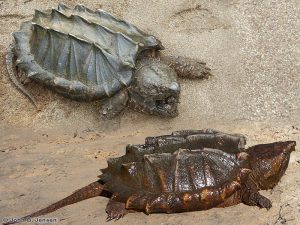
The ridged backs of the alligator snapping turtle. Photo: University of Florida
This animal is more nocturnal than their cousin and are not seen very often. They are basically carnivores and known to feed on fish, invertebrates, amphibians, birds, small mammals, reptiles, small alligators, and acorns are common in their guts. This species possesses a long tongue which they use as a fishing lure to attract prey.
Alligator snappers have a much shorter nesting season than most turtles; April to May. And, unlike other turtles, only lay one clutch of eggs per season. They typically lay between 17-52 eggs, sex determination is also controlled by the temperature of the incubating egg, and they may have strong site fidelity with nesting. Male alligators are very aggressive towards each other in captivity. This suggests strong territorial disputes occur in the wild. These live a bit longer than common snappers; reaching an age of 80 years.
Though still common, both species have seen declines in their populations in recent years. Dredge and fill projects have reduced habitat for the common snapper. Dams within the rivers and commercial harvest have impacted alligator snapper numbers. The alligator snapper is currently listed as an imperiled species in Florida and is a no-take animal (including eggs). Because the common snapper looks so similar, they are listed as a no-take species as well.
Both of these “dinosaur” looking creatures are amazing and we are lucky to have them in our backyards.
References
Meylan P.A. (Ed). 2006. Biology and Conservation of Florida Turtles. Chelonian Research Monographs No.3, 376 pp.
FWC – Freshwater Turtles
https://myfwc.com/wildlifehabitats/wildlife/freshwater-turtles/.

by Rick O'Connor | Jan 8, 2020
How cool, there is nothing wrong with other animals, but how cool for a year to be dedicated to turtles. And how fitting for the Florida panhandle. Based on the publication Biology and Conservation of Florida Turtles (2006), there are 38 taxa of turtles in our state. The majority of these can be found in the panhandle, particularly near the Apalachicola and Escambia Rivers. Within our state some species are only found at these two locations, and some are only found there on the planet.
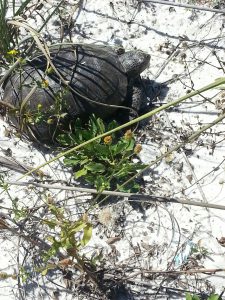
A terrestrial gopher tortoise crossing the sand on Pensacola Beach.
Photo: DJ Zemenick
Everyone loves turtles.
I hear a lot of stories about families trying to rescue while they are crossing highways. And when it comes to conservation, most will tell you “don’t mess with the turtles”. They are not kola bears… but they’re close. So, we are excited that 2020 is not only the year to Embrace the Gulf of Mexico, but also the Year of Turtle, and we plan to post one article a month highlighting the species richness of our area.
Let’s start with turtles in general.
Most know they are vertebrates but may not know the backbone and ribs support the framework for their famous shell. The top portion of this shell, where the backbone is, is called the carapace. The hard portion covering their chest area is the plastron. And they are connected by the bridge. The shell is a series of bony plates covered with scales (scutes). These scales are what put them in the class Reptilia. Fish also have scales but differ from reptiles in that they have gills instead of lungs. Most turtles are excellent swimmers, but they must hold their breath underwater, and some can do this for quite a long time.
All turtles are in the same Order Chelonia. The terms tortoise and terrapin are more cultural than biological. There are 7 families, and 25 species, of turtles found in Florida. Some are marine, and some terrestrial, but most are what we call “riverine”, living in freshwater.
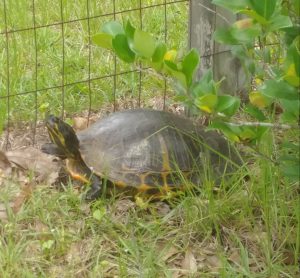
This aquatic Florida Cooter was found crossing a locals yard.
Photo: Deb Mozert
Turtles lack teeth but do have a blade like beak they can cut with. In general, smooth blades are carnivorous, serrated ones herbivorous, and their omnivorous turtles as well. Most prey are small, and most carnivores must conceal themselves to ambush their prey. Though depicted as slow animals in fairy tales and stories, turtles can be quite fast for a few seconds.
Most are diurnal (active during daylight hours) but some nocturnal activity does occur. They spend parts of their day basking on logs and other platforms to warm – turtles are ectothermic and rely on the sun for heat.
Mating occurs in the spring. And despite the fact that most are aquatic, nesting occurs on land for all. Except for a few live bearers, reptiles lay cledoic eggs (shelled) buried on dry ground. Sex is determined by the temperature of the egg in all except the softshell turtles, with eggs at 30° C or higher producing females.
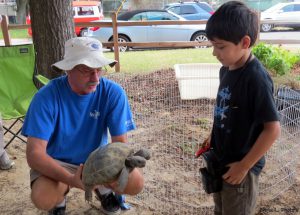
Teaching our youth about the great diversity of Florida’s turtles.
Photo: Molly O’Connor
Despite their need for warm climates, they can be found throughout the United States. But it is the warm humid southeast where they thrive. Especially the northern Gulf Coast where 60″ of rainfall each year is the norm. We will bring you an article about a new species every other week throughout this year.
Let’s Celebrate the Year if the Turtle.
























